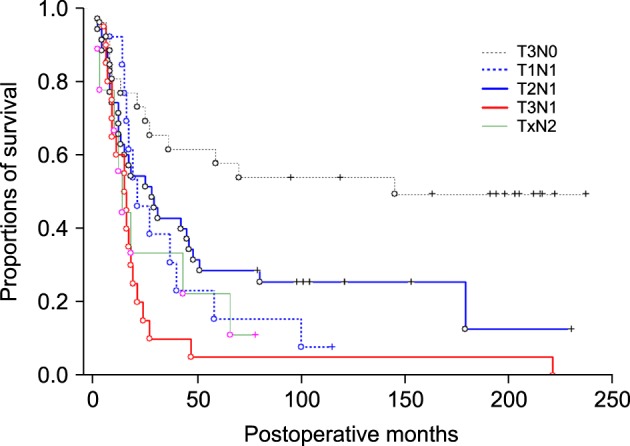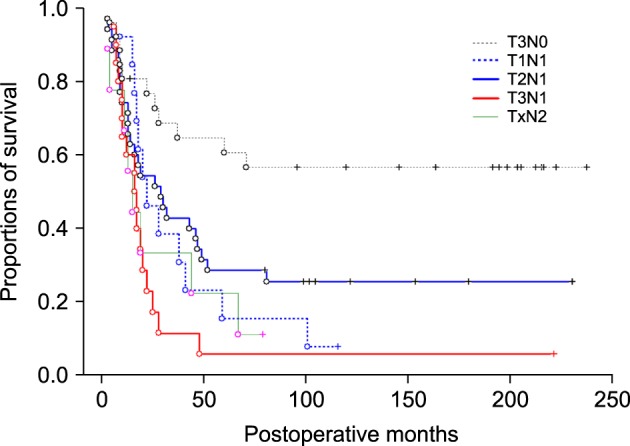Korean J Hepatobiliary Pancreat Surg.
2015 Feb;19(1):11-16. 10.14701/kjhbps.2015.19.1.11.
Survival analysis following resection of AJCC stage III gallbladder carcinoma based on different combinations of T and N stages
- Affiliations
-
- 1Department of Surgery, Asan Medical Center, University of Ulsan College of Medicine, Seoul, Korea. shwang@amc.seoul.kr
- KMID: 1802234
- DOI: http://doi.org/10.14701/kjhbps.2015.19.1.11
Abstract
- BACKGROUNDS/AIMS
According to 7th AJCC TNM staging system, gallbladder carcinoma (GBC) with lymph node (LN) metastasis is classified as N1 or N2; thus making the stage IIIB (N1) or IVB (N2). Stage IIIB consists of N1 status with wide coverage of T1-3, but T3N1 group often showed poorer outcomes than T1-2N1 groups. This study intended to assess post-resection prognosis of T3N1 versus other stage III subgroups.
METHODS
We selected 103 patients from our institutional database of GBC who underwent R0 resection between July 1996 and June 2009 and whose GBC was confined to stage T3N0, T1-3N1 or T1-3N2. These patients were stratified into five groups, namely, T3N0 (n=26), T1N1 (n=13), T2N1 (n=35), T3N1 (n=20) and T1-3N2 (n=9), and were followed for > or =5 years or until death.
RESULTS
Surgical procedures were minor liver resection (n=53), minor liver resection with bile duct resection (n=23), major liver resection (n=12), major liver resection with bile duct resection (n=5), and hepatopancreatoduodenectomy (n=12). Mean follow-up period was 57.2+/-68.5 months. Overall 5-year survival rate based on all-cause death and cancer-associated death, respectively, was 57.7% and 60.6% in T3N0, 15.4% and 15.4% in T1N1 (n=13), 28.6% and 28.6% in T2N1 (n=35), 5.0% and 5.7% in T3N1 (n=20), and 22.2% and 22.2% in T1-3N2. The survival outcome of T3N1 group was the poorest among the four stage III groups and was comparable to that of stage IVB (p=0.53).
CONCLUSIONS
The prognosis of T3N1 GBC is unusually poor even after R0 resection, thus we suggest extensive LN dissection may be necessary in patients with T3 tumors for accurate prognostic evaluation and radical removal of potential nodal micrometastasis. Further validation of this result is necessary in large patient populations from multiple centers.
MeSH Terms
Figure
Reference
-
1. Wakai T, Shirai Y, Sakata J, Nagahashi M, Ajioka Y, Hatakeyama K. Mode of hepatic spread from gallbladder carcinoma: an immunohistochemical analysis of 42 hepatectomized specimens. Am J Surg Pathol. 2010; 34:65–74. PMID: 19956061.
Article2. Chikamoto A, Tsuji T, Nakahara O, Sakamoto Y, Ikuta Y, Tanaka H, et al. Cancer cells spread through lymph vessels in the submucosal layer of the common bile duct in gallbladder carcinoma. J Hepatobiliary Pancreat Surg. 2009; 16:557–561. PMID: 19373429.
Article3. Nakata T, Kobayashi A, Miwa S, Soeda J, Miyagawa S. Impact of tumor spread to the cystic duct on the prognosis of patients with gallbladder carcinoma. World J Surg. 2007; 31:155–161. PMID: 17180477.
Article4. Yang XW, Yang J, Li L, Man XB, Zhang BH, Shen F, et al. Analysis of the relationships between clinicopathologic factors and survival in gallbladder cancer following surgical resection with curative intent. PLoS One. 2012; 7:e51513. PMID: 23300551.
Article5. Oh TG, Chung MJ, Bang S, Park SW, Chung JB, Song SY, et al. Comparison of the sixth and seventh editions of the AJCC TNM classification for gallbladder cancer. J Gastrointest Surg. 2013; 17:925–930. PMID: 23299221.
Article6. Edge SB, Byrd DR, Compton CC, Fritz AG, Greene FL, Trotti A 3rd. AJCC cancer staging manual. 7th ed. New York: Springer;2009. .7. Araida T, Higuchi R, Hamano M, Kodera Y, Takeshita N, Ota T, et al. Should the extrahepatic bile duct be resected or preserved in R0 radical surgery for advanced gallbladder carcinoma? Results of a Japanese Society of Biliary Surgery Survey: a multicenter study. Surg Today. 2009; 39:770–779. PMID: 19779773.
Article8. Chikamoto A, Tsuji T, Nakahara O, Sakamoto Y, Ikuta Y, Tanaka H, et al. Cancer cells spread through lymph vessels in the submucosal layer of the common bile duct in gallbladder carcinoma. J Hepatobiliary Pancreat Surg. 2009; 16:557–561. PMID: 19373429.
Article9. Tsukada K, Kurosaki I, Uchida K, Shirai Y, Oohashi Y, Yokoyama N, et al. Lymph node spread from carcinoma of the gallbladder. Cancer. 1997; 80:661–667. PMID: 9264348.
Article10. Chijiiwa K, Yamaguchi K, Tanaka M. Clinicopathologic differences between long-term and short-term postoperative survivors with advanced gallbladder carcinoma. World J Surg. 1997; 21:98–102. PMID: 8943185.
Article11. Tsukada K, Hatakeyama K, Kurosaki I, Uchida K, Shirai Y, Muto T, et al. Outcome of radical surgery for carcinoma of the gallbladder according to the TNM stage. Surgery. 1996; 120:816–821. PMID: 8909516.
Article12. Todoroki T, Kawamoto T, Takahashi H, Takada Y, Koike N, Otsuka M, et al. Treatment of gallbladder cancer by radical resection. Br J Surg. 1999; 86:622–627. PMID: 10361182.
Article13. Japanese Society of Biliary Surgery. Classification of biliary tract carcinoma. 2nd ed. Tokyo: Kanehara;2004.14. Kishi Y, Shimada K, Hata S, Oguro S, Sakamoto Y, Nara S, et al. Definition of T3/4 and regional lymph nodes in gallbladder cancer: which is more valid, the UICC or the Japanese staging system? Ann Surg Oncol. 2012; 19:3567–3573. PMID: 22890597.
Article15. Sasaki E, Nagino M, Ebata T, Oda K, Arai T, Nishio H, et al. Immunohistochemically demonstrated lymph node micrometastasis and prognosis in patients with gallbladder carcinoma. Ann Surg. 2006; 244:99–105. PMID: 16794394.
Article16. Tanabe M, Endo I, Masunari H, Sugita M, Morioka D, Ishikawa T, et al. Is lymph-node micrometastasis in gallbladder cancer a significant prognostic factor. Hepatogastroenterology. 2012; 59:31–35. PMID: 22251520.17. Nagakura S, Shirai Y, Yokoyama N, Hatakeyama K. Clinical significance of lymph node micrometastasis in gallbladder carcinoma. Surgery. 2001; 129:704–713. PMID: 11391369.
Article18. Kai M, Chijiiwa K, Ohuchida J, Nagano M, Hiyoshi M, Kondo K. A curative resection improves the postoperative survival rate even in patients with advanced gallbladder carcinoma. J Gastrointest Surg. 2007; 11:1025–1032. PMID: 17508256.
Article19. Murakami Y, Uemura K, Sudo T, Hashimoto Y, Nakashima A, Kondo N, et al. Is para-aortic lymph node metastasis a contraindication for radical resection in biliary carcinoma? World J Surg. 2011; 35:1085–1093. PMID: 21400012.
Article20. Nishio H, Nagino M, Ebata T, Yokoyama Y, Igami T, Nimura Y. Aggressive surgery for stage IV gallbladder carcinoma; what are the contraindications? J Hepatobiliary Pancreat Surg. 2007; 14:351–357. PMID: 17653632.
Article21. Gold DG, Miller RC, Haddock MG, Gunderson LL, Quevedo F, Donohue JH, et al. Adjuvant therapy for gallbladder carcinoma: the Mayo Clinic Experience. Int J Radiat Oncol Biol Phys. 2009; 75:150–155. PMID: 19297105.
Article22. Jeong Y, Park JH, Lee YJ, Park KM, Hwang S, Chang HM, et al. Postoperative radiotherapy for gallbladder cancer. Anticancer Res. 2014; 34:5621–5629. PMID: 25275065.23. Murakami Y, Uemura K, Hayasidani Y, Sudo T, Hashimoto Y, Ohge H, et al. Indication for postoperative adjuvant therapy in biliary carcinoma based on analysis of recurrence and survival after surgical resection. Dig Dis Sci. 2009; 54:1360–1364. PMID: 18975086.
Article24. Sasaki R, Itabashi H, Fujita T, Takeda Y, Hoshikawa K, Takahashi M, et al. Significance of extensive surgery including resection of the pancreas head for the treatment of gallbladder cancer--from the perspective of mode of lymph node involvement and surgical outcome. World J Surg. 2006; 30:36–42. PMID: 16369715.
Article
- Full Text Links
- Actions
-
Cited
- CITED
-
- Close
- Share
- Similar articles
-
- Survival Factors of Gallbladder Carcinoma
- A Comparison of Fifth-Edition and Sixth-Edition American Joint Committee Staging System for Sinonasal Squamous Cell Carcinoma
- Comparison of New AJCC Staging System with Old AJCC Staging System in Nasopharyngeal Carcinoma
- Surgical outcome and prognostic factors in patients with gallbladder carcinoma
- Radical Surgery for Carcinoma of the Gallbladder



